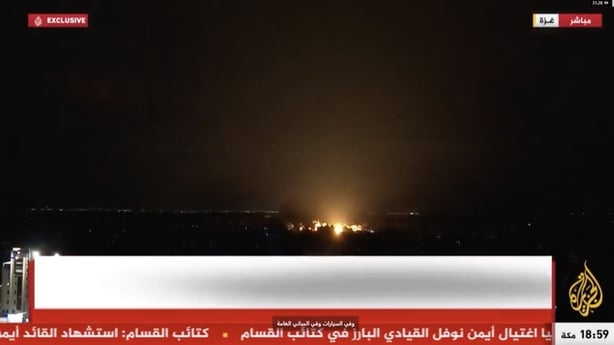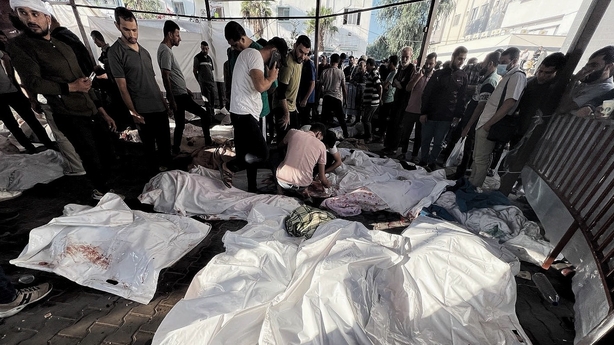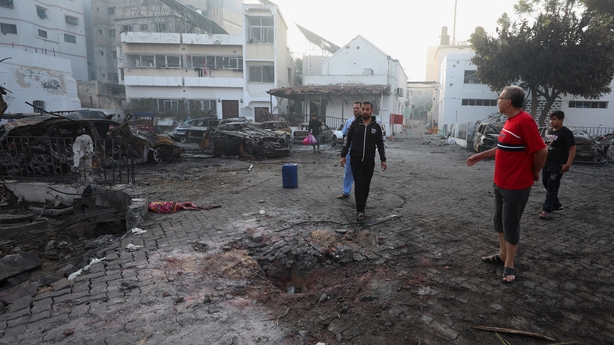The blast at Al-Ahli hospital in Gaza on Tuesday saw hundreds of people reported killed and triggered a wave of protests across the Middle East.
It resulted in leaders of Arab countries cancelling planned meetings with US President Joe Biden, and saw Israel and Palestinian groups directing blame at each other for what may turn out to be a war crime.
With organisations like Amnesty International calling for an independent investigation to establish the full facts, what is known about what happened as it stands?
The Hospital
Al-Ahli Hospital is located in the Zeitoun neighbourhood of Gaza City, in the northern region of the Gaza Strip.
Gaza City was home to more than 600,000 people prior to the recent resurgence in violence. Since the Hamas attacks on southern Israel on 7 October, large parts of Gaza City have been destroyed as part of campaign of air strikes by the Israeli air force.
6,000 bombs were dropped on the enclave between 7 October and 12 October alone, according to the Israeli military.
On Friday, the Israeli military said everyone living in the area around Gaza City should evacuate to the south of the Wadi Gaza, a wetlands in the centre of the strip, and it appeared an Israeli ground invasion loomed.
Many Palestinians in Gaza did move south. However, with air strikes continuing across the whole enclave, many had nowhere to go, or had no option to leave for healthcare or other reasons. Instead, they sought safety in other ways.
Founded 1882 and run by the Anglican church, Al-Ahli hospital has 80 beds and run services to detect breast cancer, a centre for elderly women, and a mobile clinic offering care in surrounding towns.
Although it had a limited number of beds, the hospital and others in Gaza have been crammed with casualties beyond their capacity since the start of the campaign of air strikes.
As well as handling a surge in the number of wounded, people have been seeking refuge in hospital grounds all over Gaza, believing them to be safe havens against strikes.
Dr Fadel Naim, head of orthopaedic surgery, told the Reuters news agency that about 1,000 people were in the hospital on Tuesday morning.
The hours before the blast
At 8am local time, the Arabic-language spokesman for the Israeli military posted a video on Twitter, specifically referencing the Zeitoun area. He said "the neighbourhood is full of Hamas dens" and warned residents they should move south.
Dr Ibrahim Al-Naqa from the hospital told Reuters that in the wake of the IDF message, more people rushed to the hospital grounds, and more than 3,000 people were there at the time of the blast.
The hospital is made up of several buildings which horseshoe around a central courtyard and car park.

The explosion
The blast occurred at 18.59 local time. We know that because Arabic news channel Al Jazeera was broadcasting live and streaming the broadcast to Facebook.
The reporter was positioned less than two kilometers away from the hospital, at a location overlooking the Zeitoun neighbourhood.
In the previous days, Hamas and other groups in Gaza had been regularly firing rockets from the enclave into southern and western Israel, reaching cities a far north as Tel Aviv, more than 70km away. In the hour before the explosion at the hospital, incoming rocket sirens had gone off in towns like Ashkelon, 20km north of Gaza City.
In the broadcast, a trail of rocket fire can be seen emerging up from the Gaza skyline. The Al Jazeera camera operator pans the camera to track a rocket as it arcs into the night sky, but seconds into its flight it erupts mid-air into flames.
Moments later a small explosion occurs on the ground to the left of the shot, then almost immediately afterwards a huge fireball erupts in the middle foreground of the shot, casting the silhouette of the hospital buildings against orange.

The resultant argument over who is to blame for the blast at Al-Ahli hospital rests on whether the rocket which ignited mid-air fell at the hospital and exploded, or whether a separate Israeli air strike occurred at the same time.
The Gaza Health Ministry, part of the Hamas-run government in the enclave, immediately blamed Israel. A spokesman accused Israel of "a massacre," as Hamas itself said it was a "war crime."
Israel denied responsibility. It blamed the Palestinian Islamic Jihad group – a smaller more religiously-radical militant group which also operates in Gaza - saying "the hospital was hit as a result of a failed rocket launched by the Islamic Jihad terrorist organisation."
The Israeli military said it "had not conducted any strikes - by air, navy or land - in the vicinity of the hospital at that time."
Palestinian Islamic Jihad denied being responsible and blamed Israel. It says it had the warhead to prove the explosive used came from Israel, but it did not provide any evidence for that.

The aftermath
From the hospital, footage of first responders placing people into ambulances and body bags began to emerge. Many of the victims appear to have been women and children.
Later, images were published from the nearby Al-Shifa Hospital, where many of the victims were taken and appear to have burn injuries.
On Wednesday, daylight images began to emerge of the aftermath of the blast.
In the car park, around a dozen vehicles have been destroyed by fire. One can be seen upturned.

On the grassy areas within the hospital complex, mattresses, pillows and bedding that people appear to have brought from home is strewn across the area. Damage to railings around those open areas can also be seen.
In other footage and imagery that emerged on Wednesday, blood-stained outside walls were seen.
The hospital buildings remain standing, although many of the windows are blown out.
A small crater is visible in the car park about one-metre by one-metre in size, which experts say is more typical of mortar fire than an air strike.
For that reason, several weapons experts have questioned the assertion that an air strike caused the blast at the hospital.
One, Marc Garlasco, a former United Nations war crimes investigator who specialised in issues related to civilian harm, said on Twitter "whatever hit the hospital in Gaza it wasn't an airstrike."
"Even the smallest JDAM leaves a 3m crater. Widespread surface damage and total lack of cratering inconsistent with an airstrike."
A JDAM is a type of air-dropped bomb.

As the finger of blame was pointed squarely at Israel from across the Arab world, Jordan’s King Abdullah cancelled a summit that was due to attended by the presidents of the United States, Egypt and the Palestinian Authority.
The Israeli military held a press conference in which it released an 'aftermath report'.
It published several maps and audio files which it says were intercepted phone calls between Hamas operatives, to back up its version of events.
Some Arabic speakers familiar with the accent and nuances of language used in Gaza expressed doubts about the authenticity of the conversations.
The people which Israel says are Hamas operatives speaking in the intercepted phone call discuss the incident, saying Islamic Jihad were firing rockets at the time.
"They shot it from the cemetery behind the hospital..." one says. The hospital is located adjacent and opposite to a large Christian cemetery.
However, in the same release the Israeli military also released a map which labeled the rocket launch site almost two kilometers south-west of the hospital.
Later on Thursday, several international media outlets cited 'intelligence community' sources in reports questioning the scale of fatalities purported by the Gaza Health Ministry.
Meanwhile, Amnesty International, other similar organisations, and politicians across the world - including Tánaiste Micheál Martin - called for an independent and impartial investigation to be held into what happened.
Additional reporting via Reuters

